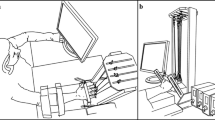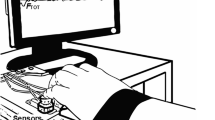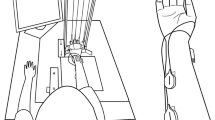Abstract
We used the uncontrolled manifold (UCM) approach to study the synergy formation during learning an unusual multi-finger task. The subjects produced accurate force ramps with challenging sets of four fingers (two per hand). We tested hypotheses on stabilization of the contributions of subsets of effectors to the task force (F TASK) and to the moment in the frontal plane (force-stabilization and moment-stabilization, respectively). Force signals were used to compute magnitudes of hypothetical independent signals, modes. The variance of the mode magnitudes across repetitions of the task was partitioned into two components, within the UCM (V UCM), which did not affect the average value of a selected performance variable (force or moment), and orthogonal to the UCM (V ORT), which affected the variable. Prior to practice, subjects showed high error indices and failed to show stabilization of each hand’s contribution to F TASK (V ORT≥V UCM), while the pronation-supination moment was stabilized by the fingers of each hand (V ORT<V UCM). The total forces produced by each of the two hands showed negative covariation across trials, which supported the force-stabilization hypothesis but not moment-stabilization hypothesis. Both force-stabilization and moment-stabilization hypotheses were supported by analysis of mode magnitudes to all eight fingers. Over 2 days of practice, the performance of the subjects improved considerably. This was accompanied by the emergence of within-a-hand force-stabilization for each of the two hands without deterioration of moment-stabilization. Quantitatively better within-a-hand force-stabilization was seen in male subjects as compared to females throughout the course of the experiment. Force-stabilization by all eight fingers improved quantitatively with practice. Practice also resulted in higher finger forces in maximal force production (MVC) trials and higher forces produced by unintended fingers in single-finger MVC trials (higher enslaving). We conclude that the UCM approach allows quantifying changes in the coordination of effectors during practice, and offers insights into the microstructure of this coordination with respect to different performance variables and different subsets of effectors. The approach can be used to test whether new synergies emerge in the process of practice.








Similar content being viewed by others
References
Al-Falahe NA, Nagaoka M, Vallbo AB (1990) Lack of fusimotor modulation in a motor adaptation task in man. Acta Physiol Scand 140:23–30
Bernstein NA (1967) The coordination and regulation of movements. Pergamon Press, London
Bernstein NA (1996) On dexterity and its development. In: Latash ML, Turvey MT (eds) Dexterity and its development. Erlbaum, Mahwah, NJ, pp 277–304
Carroll TJ, Riek S, Carson RG (2001) Corticospinal responses to motor training revealed by transcranial magnetic stimulation. Exerc Sport Sci Rev 29:54–59
Classen J, Liepert J, Wise SP, Hallett M, Cohen LG (1998) Rapid plasticity of human cortical movement representation induced by practice. J Neurophysiol 79:1117–1123
Danion F, Schöner G, Latash ML, Li S, Scholz JP, Zatsiorsky VM (2003) A force mode hypothesis for finger interaction during multi-finger force production tasks. Biol Cybern 88:91–98
Domkin D, Laczko J, Jaric S, Johansson H, Latash ML (2002) Structure of joint variability in bimanual pointing tasks. Exp Brain Res 143:11–23
Feldman AG (1986) Once more on the equilibrium-point hypothesis (λ model) for motor control. J Mot Behav 18:17–54
Feldman AG, Levin MF (1995) The origin and use of positional frames of reference in motor control. Behav Brain Sci 18:723–804
Feldman AG, Ostry DJ, Levin MF, Gribble PL, Mitnitski AB (1998) Recent tests of the equilibrium-point hypothesis (lambda model). Motor Control 2:189–205
Gelfand IM, Tsetlin ML (1966) On mathematical modeling of the mechanisms of the central nervous system. In: Gelfand IM, Gurfinkel VS, Fomin SV, Tsetlin ML (eds) Models of the structural-functional organization of certain biological systems. Nauka, Moscow (in Russian, a translation is available in 1971 edn by MIT Press), pp 9–26
Hamilton RH, Pascual-Leone A (1998) Cortical plasticity associated with Braille learning. Trends Cogn Sci 2:168–174
Latash ML (1993) Control of human movement. Human Kinetics, Urbana, IL
Latash ML, Scholz JP, Danion F, Schöner G (2001) Structure of motor variability in marginally redundant multi-finger force production tasks. Exp Brain Res 141:153–165
Latash ML, Kang N, Patterson D (2002a) Finger coordination in persons with Down syndrome: atypical patterns of coordination and the effects of practice. Exp Brain Res 146:345–355
Latash ML, Scholz JP, Danion F, Schöner G (2002b) Finger coordination during discrete and oscillatory force production tasks. Exp Brain Res 146:412–432
Latash ML, Scholz JP, Schöner G (2002c) Motor control strategies revealed in the structure of motor variability. Exerc Sport Sci Rev 30:26–31
Latash ML, Yarrow K, Rothwell JC (2003) Changes in finger coordination and responses to single pulse TMS of motor cortex during practice of a multi-finger force production task. Exp Brain Res 151:60–71
Li Z-M, Latash ML, Zatsiorsky VM (1998) Force sharing among fingers as a model of the redundancy problem. Exp Brain Res 119:276–286
Li S, Danion F, Latash ML, LiZ-M, Zatsiorsky VM (2001) Bilateral deficit and symmetry in finger force production during two-hand multi-finger tasks. Exp Brain Res 141:530–540
Liepert J, Terborg C, Weiller C (1999) Motor plasticity induced by synchronized thumb and foot movements. Exp Brain Res 125:435–439
McKay DR, Ridding MC, Thompson PD, Miles TS (2002) Induction of persistent changes in the organisation of the human motor cortex. Exp Brain Res 143:342–349
Nordstrom MA, Butle SL (2002) Reduced intracortical inhibition and facilitation of corticospinal neurons in musicians. Exp Brain Res 144:336–342
Ostry DJ, Feldman AG (2003) A critical evaluation of the force control hypothesis in motor control. Exp Brain Res 153:275–288
Pascual-Leone A (2001) The brain that plays music and is changed by it. Ann N Y Acad Sci 930:315–329
Pascual-Leone A, Dang N, Cohen LG, Brasil-Neto JP, Cammarota A, Hallett M (1995) Modulation of muscle responses evoked by transcranial magnetic stimulation during the acquisition of new fine motor skills. J Neurophysiol 74:1037–1045
Sakai K, Ramnani N, Passingham RE (2002) Learning of sequences of finger movements and timing: frontal lobe and action-oriented representation. J Neurophysiol 88:2035–2046
Schieppati M, Giordano A, Nardone A (2002) Variability in a dynamic postural task attests ample flexibility in balance control mechanisms. Exp Brain Res 144:200–210
Scholz JP, Schöner G (1999) The uncontrolled manifold concept: identifying control variables for a functional task. Exp Brain Res 126:289–306
Scholz JP, Danion F, Latash ML, Schöner G (2002) Understanding finger coordination through analysis of the structure of force variability. Biol Cybern 86:29–39
Scholz JP, Kang N, Patterson D, Latash ML (2003) Uncontrolled manifold analysis of single trials during multi-finger force production by persons with and without Down syndrome. Exp Brain Res 153:45–58
Shim JK, Latash ML, Zatsiorsky VM (2003a) Prehension synergies: trial-to-trial variability and hierarchical organization of stable performance. Exp Brain Res 152:173–184
Shim JK, Latash ML, Zatsiorsky VM (2003b) The central nervous system needs time to organize task-specific co-variation of finger forces. Neurosci Lett 353:72–74
Shinohara M, Li S, Kang N, Zatsiorsky VM, Latash ML (2003) Effects of age and gender on finger coordination in maximal contractions and submaximal force matching tasks. J Appl Physiol 94:259–270
Slobounov S, Chiang H, Johnston J, Ray W (2002) Modulated cortical control of individual fingers in experienced musicians: an EEG study. Clin Neurophysiol 113:2013–2024
Todorov E, Jordan MI (2002) Optimal feedback control as a theory of motor coordination. Nature Neurosci 5:1226–1235
Turvey MT (1990) The challenge of a physical account of action: a personal view. In: Whiting HTA, Meijer OG, van Wieringen PCW (eds) The natural-physical approach to movement control. VU University Press, Amsterdam, pp 57–92
Vallbo AB, al-Falahe NA (1990) Human muscle spindle response in a motor learning task. J Physiol 421:553–568
Vereijken B, van Emmerick REA, Whiting HTA, Newell KM (1992) Free(z)ing degrees of freedom in skill acquisition. J Mot Behav 24:133–142
Zatsiorsky VM, Li Z-M, Latash ML (1998) Coordinated force production in multi-finger tasks. Finger interaction, enslaving effects, and neural network modeling. Biol Cybern 79:139–150
Zatsiorsky VM, Gao F, Latash ML (2003) Prehension synergies: effects of object geometry and prescribed torques. Exp Brain Res 148:77–87
Acknowledgements
We are grateful to Jae Kun Shim and Halla Olafsdottir for their help with running the experiments and to John Scholz for many helpful discussions. The study was partly supported by NIH grants NS-35032 and AG-018751.
Author information
Authors and Affiliations
Corresponding author
Rights and permissions
About this article
Cite this article
Kang, N., Shinohara, M., Zatsiorsky, V.M. et al. Learning multi-finger synergies: an uncontrolled manifold analysis. Exp Brain Res 157, 336–350 (2004). https://doi.org/10.1007/s00221-004-1850-0
Received:
Accepted:
Published:
Issue Date:
DOI: https://doi.org/10.1007/s00221-004-1850-0




